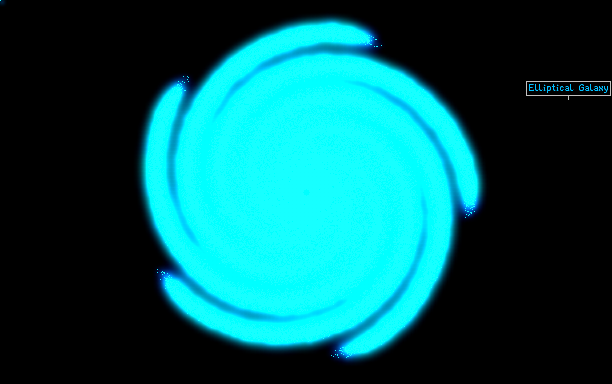Galaxy_Simulation by Skitz

Particles' positions and colors were calculated with a Lua script I put together. View with decorations enabled (preferably also with viewing mode 8) and unpause to watch the gravity diffuse the galaxy into a cloud of particles orbiting a central mass.
spiral
dontpress7
spore
galaxy
bigbang
universe
gravity
nothingdisplay
changegpmptemp
Comments
-
Hurrikan 4th Jul 2016
 More like a globular cluster, assuming that every perticle is one star.
More like a globular cluster, assuming that every perticle is one star. -
Skitz 3rd Jul 2016
 I used something I found more simple. I wish I could give some more psuedo-code, but it is not very easy trying to type into a comment box. I gave polar offsets (offsetX and offsetY) and got the velocity magnitude with a real formula (orbitVelMag = sqrt((G * M)/orbitDist)) where the mass (M) was just something random.
I used something I found more simple. I wish I could give some more psuedo-code, but it is not very easy trying to type into a comment box. I gave polar offsets (offsetX and offsetY) and got the velocity magnitude with a real formula (orbitVelMag = sqrt((G * M)/orbitDist)) where the mass (M) was just something random. -
msasterisk 3rd Jul 2016
 The arctan will cause some problems with the different quadrants, so if there is something like arctan2, that's better.
The arctan will cause some problems with the different quadrants, so if there is something like arctan2, that's better. -
msasterisk 3rd Jul 2016
 For TPT, vx = -sin(arctan((vertical distance)/(horizontal distance)))*(Previous orbital velocity equation) and vy = cos(arctan(etcetera...
For TPT, vx = -sin(arctan((vertical distance)/(horizontal distance)))*(Previous orbital velocity equation) and vy = cos(arctan(etcetera... -
msasterisk 3rd Jul 2016
 Orbital velocity equation: velocity = (orbital velocity at one unit away)/sqrt(distance)
Orbital velocity equation: velocity = (orbital velocity at one unit away)/sqrt(distance) -
diehard899 3rd Jul 2016
 *3 display
*3 display -
diehard899 3rd Jul 2016
 if you look at in 7 display it looks liek a wormhole
if you look at in 7 display it looks liek a wormhole -
NotNeverButNOW 3rd Jul 2016
 When you put a pressure bomb in the middle it will cause the galaxy it literally spin the swirly things (cant remember the name of them) around the black hole until it is sucked into the black hole.
When you put a pressure bomb in the middle it will cause the galaxy it literally spin the swirly things (cant remember the name of them) around the black hole until it is sucked into the black hole. -
NotNeverButNOW 3rd Jul 2016
 I put a big bang bomb in the center, and it looked beast lol
I put a big bang bomb in the center, and it looked beast lol -
Kittygamer9105 3rd Jul 2016
 if you put deuterium around the galaxy the galaxy will expand since deuterium is highly reactive in neutrons
if you put deuterium around the galaxy the galaxy will expand since deuterium is highly reactive in neutrons